Overview
- Brief Narrative
- DRL Sport Badge, silver grade, with swastika awarded to Carl Werner Lenneberg. DRL [Deutscher Reichsbund für Leibesübungen / German Imperial Commission for Physical Exercise] replaced the DRA [Deutscher Reichs-Ausschuss / German National Committee for Physical Training) in 1934. The silver grade badge was for those from 18-32 who passed the national fitness test for 8 years or those from 32-40 who passed the tests within a 12 month period. The 1913 Olympics and Germany's selection as the next host city generated widespread interest in physical fitness and led to the institution of a national sports badge. Earning a badge was a significant accomplishment. In January 1933, Hitler and the Nazi regime took power. Anti-Jewish policies put increasingly harsh restrictions on Jewish life. Werner and his brother Georg were arrested during Kristallnacht, November 9-10, 1938, and sent to Dachau concentration camp. After their release, they left Germany on the ill-fated voyage of the MS St. Louis to Havana, Cuba, May 13-June 17, 1939. Upon the ship's forced return to Europe, Carl and George were in the group given asylum in Belgium. In April 1940, they sailed from Antwerp to New York. a
- Date
-
manufacture:
approximately 1935-approximately 1937
- Geography
-
manufacture:
Jena (Germany)
- Credit Line
- United States Holocaust Memorial Museum Collection, Gift of Ron Lenneberg
- Markings
- center design : DRL [Deutscher Reichsausschuss für Leibesübungen / German Imperial Commission for Physical Exercise]
back, sides, embossed : D.R.G.M. 8526(8?) / WERNSTEIN JENA [Deutsches Reichsgebrauchsmuster German Nationally Registered Design] - Contributor
-
Subject:
Carl W. Lenneberg
Manufacturer: Wernstein
- Biography
-
Carl Werner Lenneberg (1899-1989) was born on November 5, 1899 in Remscheid, Germany and had an older brother Georg (b. 1898). Their father, and later Carl and his family, owned a store in Remscheid. Carl was a soldier in the 8th (Rhenish) Foot Artillery Reserve Battalion, XVI Army Corps, German Army, during the First World War. He was awarded several medals for his combat service. Carl’s fiancé, Hildegarde Hilb (Hilde, b. 1912 in Ulm) immigrated to the United States in May 1937. Carl and Georg were arrested during Kristallnacht in November 1938 and sent to Dachau concentration camp. They were released in December.
Carl, Georg, and Fritz Hilb (b.1919 in Ulm), Hilde’s brother, booked passage on the MS St. Louis and left for Havana, Cuba, on May 13, 1939, with 937 passengers. During the voyage, Carl wrote nearly daily letters to Hilde as well as others in Germany and kept a diary. After the ship was denied entry in Cuba and returned to Europe they disembarked in Antwerp, Belgium and got an apartment in Brussels along with another shipmate, Fritz Buff. Carl and Georg used this time to continue learning English. Fritz Hilb left for England and, in February 1940, sailed from Liverpool on the MS Scythia. On April 11, 1940, Carl and Georg left on the SS Westernland from Antwerp, arriving in New York on April 25. On April 27, 1940 Carl married Hilde. They settled in New York City and had a son.
Physical Details
- Classification
-
Identifying Artifacts
- Category
-
Badges
- Object Type
-
Badges (lcsh)
- Physical Description
- Silver colored die-struck metal brooch in the shape of a cutout, oval, embossed oak leaf wreath with a mobile swastika set over a bow at the bottom. In the center are 3 intertwined, openwork upper case letters, DRL. On the back is a maker's mark and a soldered hinged pin and C hook.
- Dimensions
- overall: Height: 1.875 inches (4.763 cm) | Width: 1.625 inches (4.128 cm) | Depth: 0.375 inches (0.953 cm)
- Materials
- overall : metal
Rights & Restrictions
- Conditions on Access
- No restrictions on access
- Conditions on Use
- No restrictions on use
Keywords & Subjects
Administrative Notes
- Legal Status
- Permanent Collection
- Provenance
- The pin was donated to the United States Holocaust Memorial Museum in 2011 by Ron Lenneberg, the son of Carl Werner Lenneberg.
- Funding Note
- The cataloging of this artifact has been supported by a grant from the Conference on Jewish Material Claims Against Germany.
- Record last modified:
- 2023-08-31 10:43:58
- This page:
- https://collections.ushmm.org/search/catalog/irn44434
Download & Licensing
In-Person Research
- By Appointment
- Request 21 Days in Advance of Visit
- Plan a Research Visit
- Request to See This Object
Contact Us
Also in Carl Werner Lenneberg collection
The collection consists of World War I medals, ribbons, and shoulder boards, currency, a DRL sports badge, correspondence, documents, and photographs relating to the experiences of Carl Werner Lenneberg and his family before the Holocaust in Germany, during their voyage on the MS St Louis in 1939, and emigration to the United States in 1940.
Date: approximately 1918-approximately 1940
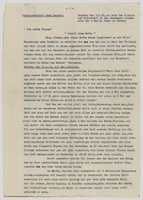
Carl Lenneberg papers
Document
The Carl Lenneberg papers include biographical materials, immigration documents, a diary, newspaper clippings, and photographs relating to Carl Lenneberg’s experiences aboard the MS St. Louis with his brother, Georg, and his future brother-in-law, Fritz Hilb. Included are documents detailing their emigration from Germany and correspondence and photographs relating to their plight aboard the St. Louis in 1939 as well as a diary Carl kept throughout the voyage. Biographical material includes a passport for Carl Lenneberg, photographic postcard and catalogs from the family store, and a certificate, identification card, and proof of membership relating to Carl’s service in World War I. The collection includes a typewritten diary kept by Carl during his time on the St Louis. In his entries, Carl writes about daily activities and the weather and provides detailed information about what he is hearing regarding not being able to disembark in Cuba, cruising to the United States, receiving information that they are being sent back to Europe, and disembarking in Belgium. Emigration and immigration material includes financial documentation, correspondence regarding Carl, Georg, and Fritz’s attempts to gain entry into Cuba, and a Cuba immigration card for Carl. Newspapers clippings include articles from Le Patriote Illustre, De Dag, and Het Laaste Nieuws relating to the St. Louis. Also included is a Los Angeles TImes article including an interview with Carl. St Louis documents include a cabin plan where Carl marked the cabin he stayed in (D368), a menu from May 21, 1939, receipts for money transfers, a book cover for Voyage of the Damned, and telegrams and correspondence to Hilde about landing in Cuba, being sent to United States, turning back to Europe, landing in Antwerp, and his departure on the SS Westerland.
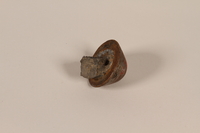
WWI anti-aircraft gun fuse fragment owned by a Jewish German soldier
Object
Fragment of a WWI anti-aircraft gun fuse saved by Carl Werner Lenneberg, a soldier in the 8th (Rhenish) Foot Artillery Reserve Battalion, XVI Army Corps, German Army, during the First World War. In January 1933, Hitler and the Nazi regime took power. Anti-Jewish policies put increasingly harsh restrictions on Jewish life. Werner and his brother Georg were arrested during Kristallnacht, November 9-10, 1938, and sent to Dachau concentration camp. After release, they left Germany on the ill-fated voyage of the MS St. Louis to Havana, Cuba, May 13-June 17, 1939. Upon the ship's forced return to Europe, Carl and George were in the group given asylum in Belgium. In April 1940, they sailed from Antwerp to New York.
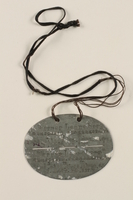
World War I German issue dog tag worn by a Jewish soldier
Object
German Army dog tag issued to Carl Werner Lenneberg, a soldier in the 8th (Rhenish) Foot Artillery Battalion, XVI Army Corps, German Army, during the First World War. In January 1933, Hitler and the Nazi regime took power. Anti-Jewish policies put increasingly harsh restrictions on Jewish life. Werner and his brother Georg were arrested during Kristallnacht, November 9-10, 1938, and sent to Dachau concentration camp. After release, they left Germany on the ill-fated voyage of the MS St. Louis to Havana, Cuba, May 13-June 17, 1939. Upon the ship's forced return to Europe, Carl and George were in the group given asylum in Belgium. In April 1940, they sailed from Antwerp to New York.
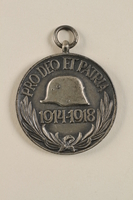
Commemorative Medal for World War I awarded to a Jewish German soldier
Object
Haborús Emlékérem kardokkal és sisakkal [Commemorative Medal for World War I], awarded to Carl Werner Lenneberg, a soldier in the 8th (Rhenish) Foot Artillery Battalion, XVI Army Corps, German Army, during the First World War. The medal was established in 1929 by the Kingdom of Hungary to acknowledge those who participated in the Great War (1914-1918.) The crossed swords and helmet mark this as the version presented to combatants. In January 1933, Hitler and the Nazi regime took power. Anti-Jewish policies put increasingly harsh restrictions on Jewish life. Werner and his brother Georg were arrested during Kristallnacht, November 9-10, 1938, and sent to Dachau concentration camp. After release, they left Germany on the ill-fated voyage of the MS St. Louis to Havana, Cuba, May 13-June 17, 1939. Upon the ship's forced return to Europe, Carl and George were in the group given asylum in Belgium. In April 1940, they sailed from Antwerp to New York.
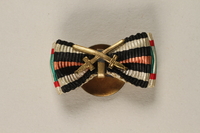
Honor Cross of the World War 1914/1918 buttonhole double ribbon bar with swords awarded to Jewish soldier
Object
German buttonhole ribbon bar with crossed swords and two ribbons awarded to Carl Werner Lenneberg, a soldier in the 8th (Rhenish) Foot Artillery Battalion, XVI Army Corps, German Army, during the First World War. The top ribbon is the Honor Cross 1914-1918 and the bottom ribbon is the Commemorative Medal for World War I. In January 1933, Hitler and the Nazi regime took power. Anti-Jewish policies put increasingly harsh restrictions on Jewish life. Werner and his brother Georg were arrested during Kristallnacht, November 9-10, 1938, and sent to Dachau concentration camp. After release, they left Germany on the ill-fated voyage of the MS St. Louis to Havana, Cuba, May 13-June 17, 1939. Upon the ship's forced return to Europe, Carl and George were in the group given asylum in Belgium. In April 1940, they sailed from Antwerp to New York.
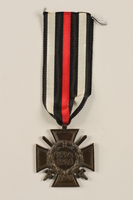
Honor Cross of the World War 1914/1918 combatant veteran service medal awarded to a German Jewish soldier
Object
Das Ehrenkreuz des Weltkriegs 1914 1918 [The Honor Cross of World War 1914/1918) awarded to Carl Werner Lenneberg for serving in combat in the German Army during the First World War. The award was established by President Paul von Hindenburg, on July 13, 1934. This was the first official WWI service medal of the Third Reich, often referred to by an unofficial name, Hindenburg Cross. Hindenburg, Field Marshal of German forces during WWI, appointed Hitler as Chancellor in January 1933, and soon a Nazi dictatorship ruled the country. Anti-Jewish policies put increasingly harsh restrictions on Jewish life. Carl and his brother were arrested during Kristallnacht, November 9-10, 1938, and sent to Dachau concentration camp. After release, they left Germany on the ill-fated voyage of the MS St. Louis, May 13-June 17, 1939. Upon the ship's forced return to Europe, Carl and George were accepted into Belgium. In April 1940, they left from Dunkirk for England, and then the United States.
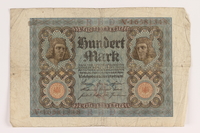
Weimar Germany, 100 mark note, saved by German Jewish refugee
Object
Weimar Germany 100 mark banknote saved by Carl Werner Lenneberg. This currency was issued by the new democratic government that ruled Germany after World War I (1914-1918), just as they entered a period of hyperinflation that threatened the stability of the county. During the war, Lenneberg was a soldier in the 8th (Rhenish) Foot Artillery Battalion, XVI Army Corps, German Army. In January 1933, Hitler and the Nazi regime took power. Anti-Jewish policies put increasingly harsh restrictions on Jewish life. Werner and his brother Georg were arrested during Kristallnacht, November 9-10, 1938, and sent to Dachau concentration camp. After release, they left Germany on the ill-fated voyage of the MS St. Louis to Havana, Cuba, May 13-June 17, 1939. Upon the ship's forced return to Europe, Carl and George were in the group given asylum in Belgium. In April 1940, they sailed from Antwerp to New York.
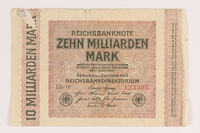
Weimar Germany, 10 billion mark note, saved by German Jewish refugee
Object
Weimar Germany 10 billion mark note saved by Carl Werner Lenneberg. This currency was issued by the new democratic government that ruled Germany after World War I (1914-1918), when it was in a period of hyper inflation that threatened the stability of the country. During the war, Lenneberg was a soldier in the 8th (Rhenish) Foot Artillery Battalion, XVI Army Corps, German Army. In January 1933, Hitler and the Nazi regime took power. Anti-Jewish policies put increasingly harsh restrictions on Jewish life. Werner and his brother Georg were arrested during Kristallnacht, November 9-10, 1938, and sent to Dachau concentration camp. After release, they left Germany on the ill-fated voyage of the MS St. Louis to Havana, Cuba, May 13-June 17, 1939. Upon the ship's forced return to Europe, Carl and George were in the group given asylum in Belgium. In April 1940, they sailed from Antwerp to New York.
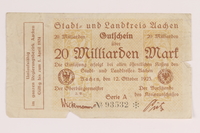
Aachen District, 20 billion mark note, saved by German Jewish refugee
Object
Aachen District, Germany 20 billion mark note saved by Carl Werner Lenneberg. This note was emergency currency, valid for one year, 1923-1924, issued by the local government in Aachen during the period of hyperinflation that threatened the stability of the country. Inflation was unstoppable: in 1919, there were 47 marks to a dollar; in 1922, it went from 1000 to 7000; in 1923, from 17,000 to 4,200,000,000,000. Lenneberg was a decorated World War I veteran orginally from Remscheid. In January 1933, Hitler and the Nazi regime took power. Anti-Jewish policies put increasingly harsh restrictions on Jewish life. Werner and his brother Georg were arrested during Kristallnacht, November 9-10, 1938, and sent to Dachau concentration camp. After release, they left Germany on the ill-fated voyage of the MS St. Louis to Havana, Cuba, May 13-June 17, 1939. Upon the ship's forced return to Europe, Carl and George were in the group given asylum in Belgium. In April 1940, they sailed from Antwerp to New York.

Remscheid 500 million mark note, saved by German Jewish refugee
Object
Remscheid District, Germany 500 million mark note saved by Carl Werner Lenneberg. This note was emergency currency, valid for one year, 1923-1924, issued by the local government in Remscheid during the period of hyperinflation that threatened the stability of the country. Inflation was unstoppable: in 1919, there were 47 marks to a dollar; in 1922, it went from 1000 to 7000; in 1923, from 17,000 to 4,200,000,000,000. Lenneberg was a decorated World War I veteran originally from Remscheid. In January 1933, Hitler and the Nazi regime took power. Anti-Jewish policies put increasingly harsh restrictions on Jewish life. Werner and his brother Georg were arrested during Kristallnacht, November 9-10, 1938, and sent to Dachau concentration camp. After release, they left Germany on the ill-fated voyage of the MS St. Louis to Havana, Cuba, May 13-June 17, 1939. Upon the ship's forced return to Europe, Carl and George were in the group given asylum in Belgium. In April 1940, they sailed from Antwerp to New York.
Honor Cross of the World War 1914/1918 ribbon awarded to a German Jewish soldier
Object
Striped ribbon of the Das Ehrenkreuz des Weltkriegs 1914 1918 [The Honor Cross of World War 1914/1918) awarded to Carl Werner Lenneberg for serving in combat in the German Army during the First World War. The award was established by President Paul von Hindenburg, on July 13, 1934. This was the first official WWI service medal of the Third Reich, often referred to by an unofficial name, Hindenburg Cross. Hindenburg, Field Marshal of German forces during WWI, appointed Hitler as Chancellor in January 1933, and soon a Nazi dictatorship ruled the country. Anti-Jewish policies put increasingly harsh restrictions on Jewish life. Carl and his brother were arrested during Kristallnacht, November 9-10, 1938, and sent to Dachau concentration camp. After release, they left Germany on the ill-fated voyage of the MS St. Louis, May 13-June 17, 1939. Upon the ship's forced return to Europe, Carl and George were accepted into Belgium. In April 1940, they left from Dunkirk for England, and then the United States.
Commemorative Medal for World War I ribbon awarded to a Jewish German soldier
Object
Ribbon of the Haborús Emlékérem kardokkal és sisakkal [Commemorative Medal for World War I], awarded to Carl Werner Lenneberg, a soldier in the 8th (Rhenish) Foot Artillery Battalion, XVI Army Corps, German Army, during the First World War. The medal was established in 1929 by the Kingdom of Hungary to acknowledge those who participated in the Great War (1914-1918.) The crossed swords and helmet mark this as the version presented to combatants. In January 1933, Hitler and the Nazi regime took power. Anti-Jewish policies put increasingly harsh restrictions on Jewish life. Werner and his brother Georg were arrested during Kristallnacht, November 9-10, 1938, and sent to Dachau concentration camp. After release, they left Germany on the ill-fated voyage of the MS St. Louis to Havana, Cuba, May 13-June 17, 1939. Upon the ship's forced return to Europe, Carl and George were in the group given asylum in Belgium. In April 1940, they sailed from Antwerp to New York.
Commemorative Medal for World War I ribbon awarded to a Jewish German soldier
Object
Striped ribbon of the Haborús Emlékérem kardokkal és sisakkal [Commemorative Medal for World War I], awarded to Carl Werner Lenneberg, a soldier in the 8th (Rhenish) Foot Artillery Battalion, XVI Army Corps, German Army, during the First World War. The medal was established in 1929 by the Kingdom of Hungary to acknowledge those who participated in the Great War (1914-1918.) The crossed swords and helmet mark this as the version presented to combatants. In January 1933, Hitler and the Nazi regime took power. Anti-Jewish policies put increasingly harsh restrictions on Jewish life. Werner and his brother Georg were arrested during Kristallnacht, November 9-10, 1938, and sent to Dachau concentration camp. After release, they left Germany on the ill-fated voyage of the MS St. Louis to Havana, Cuba, May 13-June 17, 1939. Upon the ship's forced return to Europe, Carl and George were in the group given asylum in Belgium. In April 1940, they sailed from Antwerp to New York.
Commemorative Medal for World War I wrapped ribbon awarded to a Jewish German soldier
Object
Wrapped ribbon of the Haborús Emlékérem kardokkal és sisakkal [Commemorative Medal for World War I], awarded to Carl Werner Lenneberg, a soldier in the 8th (Rhenish) Foot Artillery Battalion, XVI Army Corps, German Army, during the First World War. The medal was established in 1929 by the Kingdom of Hungary to acknowledge those who participated in the Great War (1914-1918.) The crossed swords and helmet mark this as the version presented to combatants. In January 1933, Hitler and the Nazi regime took power. Anti-Jewish policies put increasingly harsh restrictions on Jewish life. Werner and his brother Georg were arrested during Kristallnacht, November 9-10, 1938, and sent to Dachau concentration camp. After release, they left Germany on the ill-fated voyage of the MS St. Louis to Havana, Cuba, May 13-June 17, 1939. Upon the ship's forced return to Europe, Carl and George were in the group given asylum in Belgium. In April 1940, they sailed from Antwerp to New York.
WW I 61st Artillery gold shoulder boards with cannons owned by German Jewish soldier
Object
Two German 61st Artillery gold shoulder straps with crossed cannons and numeral 61 owned by Carl Werner Lenneberg, a soldier in the 8th (Rhenish) Foot Artillery Battalion, XVI Army Corps, German Army, during the First World War. In January 1933, Hitler and the Nazi regime took power. Anti-Jewish policies put increasingly harsh restrictions on Jewish life. Werner and his brother Georg were arrested during Kristallnacht, November 9-10, 1938, and sent to Dachau concentration camp. After release, they left Germany on the ill-fated voyage of the MS St. Louis to Havana, Cuba, May 13-June 17, 1939. Upon the ship's forced return to Europe, Carl and George were in the group given asylum in Belgium. In April 1940, they sailed from Antwerp to New York.
WW I 8th Artillery gold shoulder boards with cannons owned by German Jewish soldier
Object
Two German WWI 8th Artillery gold shoulder strap with crossed flaming cannons and numeral 8 owned by Carl Werner Lenneberg, a soldier in the 8th (Rhenish) Foot Artillery Battalion, XVI Army Corps, German Army, during the First World War. In January 1933, Hitler and the Nazi regime took power. Anti-Jewish policies put increasingly harsh restrictions on Jewish life. Werner and his brother Georg were arrested during Kristallnacht, November 9-10, 1938, and sent to Dachau concentration camp. After release, they left Germany on the ill-fated voyage of the MS St. Louis to Havana, Cuba, May 13-June 17, 1939. Upon the ship's forced return to Europe, Carl and George were in the group given asylum in Belgium. In April 1940, they sailed from Antwerp to New York.
WW I 8th Artillery gold shoulder board with cannons owned by German Jewish soldier
Object
Single German WWI 8th Artillery gold shoulder strap with crossed flaming cannons and numeral 8 owned by Carl Werner Lenneberg, a soldier in the 8th (Rhenish) Foot Artillery Battalion, XVI Army Corps, German Army, during the First World War. In January 1933, Hitler and the Nazi regime took power. Anti-Jewish policies put increasingly harsh restrictions on Jewish life. Werner and his brother Georg were arrested during Kristallnacht, November 9-10, 1938, and sent to Dachau concentration camp. After release, they left Germany on the ill-fated voyage of the MS St. Louis to Havana, Cuba, May 13-June 17, 1939. Upon the ship's forced return to Europe, Carl and George were in the group given asylum in Belgium. In April 1940, they sailed from Antwerp to New York.
WW I 61st Artillery gold shoulder board with cannons owned by German Jewish soldier
Object
Single German 61st Artillery gold shoulder strap with crossed cannons and numeral 61 owned by Carl Werner Lenneberg, a soldier in the 8th (Rhenish) Foot Artillery Battalion, XVI Army Corps, German Army, during the First World War. In January 1933, Hitler and the Nazi regime took power. Anti-Jewish policies put increasingly harsh restrictions on Jewish life. Werner and his brother Georg were arrested during Kristallnacht, November 9-10, 1938, and sent to Dachau concentration camp. After release, they left Germany on the ill-fated voyage of the MS St. Louis to Havana, Cuba, May 13-June 17, 1939. Upon the ship's forced return to Europe, Carl and George were in the group given asylum in Belgium. In April 1940, they sailed from Antwerp to New York.
WW I 8th Artillery gray shoulder boards with 8 worn by German Jewish soldier
Object
Two German 8th Artillery gray shoulder straps with the numeral 8 owned by Carl Werner Lenneberg, a soldier in the 8th (Rhenish) Foot Artillery Battalion, XVI Army Corps, German Army, during the First World War. In January 1933, Hitler and the Nazi regime took power. Anti-Jewish policies put increasingly harsh restrictions on Jewish life. Werner and his brother Georg were arrested during Kristallnacht, November 9-10, 1938, and sent to Dachau concentration camp. After release, they left Germany on the ill-fated voyage of the MS St. Louis to Havana, Cuba, May 13-June 17, 1939. Upon the ship's forced return to Europe, Carl and George were in the group given asylum in Belgium. In April 1940, they sailed from Antwerp to New York.
Airmail box used to store his war medals by a German Jewish refugee
Object
Airmail box used by Carl Werner Lenneberg to store his World War I (1914-1918) medals and ribbons. Lenneberg was a soldier in the 8th (Rhenish) Foot Artillery Battalion, XVI Army Corps, German Army, during the First World War. In January 1933, Hitler and the Nazi regime took power. Anti-Jewish policies put increasingly harsh restrictions on Jewish life. Werner and his brother Georg were arrested during Kristallnacht, November 9-10, 1938, and sent to Dachau concentration camp. After release, they left Germany on the ill-fated voyage of the MS St. Louis to Havana, Cuba, May 13-June 17, 1939. Upon the ship's forced return to Europe, Carl and George were in the group given asylum in Belgium. In April 1940, they sailed from Antwerp to New York.



